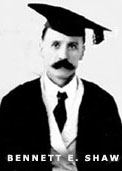
 couting is a game for boys. It combines the romantic
chivalry of knights rescuing damsels in distress with the ragamuffin
resilience of an Oliver Twist wrestling a Huck Finn in the mud,
coupled with the stoic courage of European soldiers plodding through
predator-infested savannahs of Africa and the resourcefulness of
a Thor Heyerdahl sailing the Pacific alone on his Kon Tiki. The
V.I. visionary Mr Bennett Eyre Shaw must have envisaged something akin
to this as an effective character-building programme for his boys for,
one fine day in the year 1910, he rounded up a handful of pupils from
the V.I. Scripture Class to form the first Scout Troop in Malaya.
couting is a game for boys. It combines the romantic
chivalry of knights rescuing damsels in distress with the ragamuffin
resilience of an Oliver Twist wrestling a Huck Finn in the mud,
coupled with the stoic courage of European soldiers plodding through
predator-infested savannahs of Africa and the resourcefulness of
a Thor Heyerdahl sailing the Pacific alone on his Kon Tiki. The
V.I. visionary Mr Bennett Eyre Shaw must have envisaged something akin
to this as an effective character-building programme for his boys for,
one fine day in the year 1910, he rounded up a handful of pupils from
the V.I. Scripture Class to form the first Scout Troop in Malaya.
It was a brave leap of faith for Mr Shaw because the Scout
movement was then still in its infancy. Three years earlier, on 1 August 1907,
on the shores of Brownsea Island, near the Isle of Wight in the south
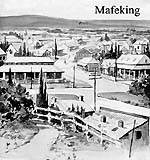 of England, 20 boys had been gathered for an experimental camp to trial
a new method for training boys, one devised by Major-General (later
Lord) Robert Stephenson Smythe Baden-Powell. That date is now considered
the official birth date of the Scout movement. Baden-Powell (or BP as
he is fondly called), had an enviable record of espionage during his
campaign in Africa in the late 1800s. However, it was in the previously
non-descript outpost of Mafeking when it dawned on him that such
skills of survival, properly taught, could be highly beneficial for
many. For 217 days in 1899, greatly outnumbered, he had commanded and
successfully defended Mafeking against 9,000 besieging Boers.
Remarkably, BP’s important ‘army’ of messenger corps had consisted mainly
of youths and teenage boys, who executed his orders most efficiently.
The story of Mafeking is the story of all Boy Scouts and to this day,
in remembrance, a flame is kept burning in perpetuity in that town.
of England, 20 boys had been gathered for an experimental camp to trial
a new method for training boys, one devised by Major-General (later
Lord) Robert Stephenson Smythe Baden-Powell. That date is now considered
the official birth date of the Scout movement. Baden-Powell (or BP as
he is fondly called), had an enviable record of espionage during his
campaign in Africa in the late 1800s. However, it was in the previously
non-descript outpost of Mafeking when it dawned on him that such
skills of survival, properly taught, could be highly beneficial for
many. For 217 days in 1899, greatly outnumbered, he had commanded and
successfully defended Mafeking against 9,000 besieging Boers.
Remarkably, BP’s important ‘army’ of messenger corps had consisted mainly
of youths and teenage boys, who executed his orders most efficiently.
The story of Mafeking is the story of all Boy Scouts and to this day,
in remembrance, a flame is kept burning in perpetuity in that town.
THE FOUNDING OF THE V.I. SCOUT MOVEMENT
The exact origins of the V.I. Scouting movement can
only be guessed at. It could have been during the time Mr Shaw was on home
leave in England, when fledgling Scout Troops mushrooming around England
would have come to his notice and inspired him to do the same on his return
to Malaya. The historical sources seem ambiguous. At any rate, on 16
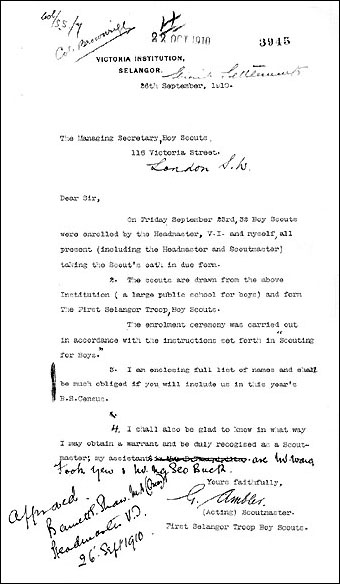 September 1910, Mr Shaw wrote a letter to the Boy Scouts Headquarters
(presumably in London, because there was as yet no headquarters in the
Straits Settlements or the Malay States). In that letter he wrote that
"we started patrols of Boy Scouts in connection with this School
a few months ago", which might suggest that the genesis of the
V.I. Scouts was in 1910. (See Mr B.E. Shaw's
letter to the London Scout HQ (1910).) The names of the Scouts were
submitted to London on Monday, 26 September 1910. Two days later, at 7 p.m.
that evening, the first meeting of the Local Committee of the Selangor Boy
Scouts was held at the Selangor Club. According to the minutes,
"Mr Shaw reported that at the Victoria Institution they formed
early in the year a troop of three patrols". This seems to
confirm the contents of Mr Shaw’s earlier letter. Likewise, in the first
edition of The Victorian (October 1923), the Scout Notes, written
by the Scout Master Mr M.A. Akbar (who had been involved in V.I. Scouting
since 1910), mentioned that "the First Selangor Troop was
founded in the year 1910 by Mr B.E. Shaw".
September 1910, Mr Shaw wrote a letter to the Boy Scouts Headquarters
(presumably in London, because there was as yet no headquarters in the
Straits Settlements or the Malay States). In that letter he wrote that
"we started patrols of Boy Scouts in connection with this School
a few months ago", which might suggest that the genesis of the
V.I. Scouts was in 1910. (See Mr B.E. Shaw's
letter to the London Scout HQ (1910).) The names of the Scouts were
submitted to London on Monday, 26 September 1910. Two days later, at 7 p.m.
that evening, the first meeting of the Local Committee of the Selangor Boy
Scouts was held at the Selangor Club. According to the minutes,
"Mr Shaw reported that at the Victoria Institution they formed
early in the year a troop of three patrols". This seems to
confirm the contents of Mr Shaw’s earlier letter. Likewise, in the first
edition of The Victorian (October 1923), the Scout Notes, written
by the Scout Master Mr M.A. Akbar (who had been involved in V.I. Scouting
since 1910), mentioned that "the First Selangor Troop was
founded in the year 1910 by Mr B.E. Shaw".
But there is a fly in this historical ointment, and it comes from Mr Akbar himself! Two years later, in the magazine Scouting In Malaya (Volume 1, Number 1, May 1925), Mr Akbar reported that the V.I. had the oldest Troop in Selangor, "having been formed in 1909". This same Scout Master, who only two years before had reported that 1910 was the founding date of the V.I. Scouts, was now saying something different! And fast forwarding to almost two decades later, we find the Scout Report penned by S. Sivanason in the 1940 Victorian, telling its readers that "...It is interesting to record that the First Selangor Troop which was founded on 15 March 1909...". This 'date of birth' was re-stated in an article on Scouting history in the 1946 Victorian and in the 1969 Victorian, though it had never surfaced in any records before 1940.
So was it 1909 or 1910?
Arguments can be pitched for either side. One could argue that the earlier sources are more reliable since they are closer to the actual event, thus justifying 1910 as the founding date. Moreover, it is questionable where this S. Sivanason had sourced his 'fact' from, especially given that stalwarts like Mr Shaw and Mr Akbar were no longer in the School by 1940. No details of Sivanason's actual or even possible sources of information are available. Perhaps it was a passing comment heard in an earshot or maybe an obscure memory of an Old Scout which was never meant to be taken as gospel. Hence, it is tenuous to pin full faith on the credibility of this statement.
On the other hand, why did Mr M.A. Akbar change his story between 1923 and 1925; stating, in 1923, that the V.I. Scouting movement was formed in 1910 while stating, two years later, that the movement was founded in 1909? One could argue that Mr Akbar might have been aware that the V.I. scout movement was ‘informally’ initiated in 1909, before the ‘formal’ genesis in 1910. This would then justify the claim of 1909 being the year of formation. More importantly, it must be noted that Mr Akbar’s 1923 report (which supports 1910 as the founding date) is not free from error. Mr Akbar had reported that Mr G. Ambler became V.I. Scout Master in 1911, whereas in fact he was already so in 1910, as evidenced by a letter written by him (and approved by Mr Shaw) to the Boy Scouts Headquarters in London, dated 26 September 1910. So maybe Mr Akbar recorded early events as happening one year later than they actually did.
Another argument can also be made to support the 1946
Victorian report that claimed 1909 as the first year for V.I. Scouting.
In 1946,
 in a belated celebration of the School's 1943 Golden Jubilee, the School
magazine published articles on the history of various institutions of
the V.I., including that of the Scouts. Mr Chan Hung Chin, an Old Boy
and former V.I. Scoutmaster was probably the author of the unsigned
article that claimed March 1909 as the founding date. And Mr Chan of
all people should certainly have known his facts. A Victorian and a
Scout himself (probably among the first), he had joined the School as
a teacher in 1914, retiring in 1940; he was a Scout Master from 1914 to
1920. He also founded the first, second and third packs of Wolf Cubs in
Selangor and later rose to be the first District Cub Master.
in a belated celebration of the School's 1943 Golden Jubilee, the School
magazine published articles on the history of various institutions of
the V.I., including that of the Scouts. Mr Chan Hung Chin, an Old Boy
and former V.I. Scoutmaster was probably the author of the unsigned
article that claimed March 1909 as the founding date. And Mr Chan of
all people should certainly have known his facts. A Victorian and a
Scout himself (probably among the first), he had joined the School as
a teacher in 1914, retiring in 1940; he was a Scout Master from 1914 to
1920. He also founded the first, second and third packs of Wolf Cubs in
Selangor and later rose to be the first District Cub Master.
But one fact is clear: The V.I. scouts were first officially recognised as the First Selangor Scout Troop in 1910. Whether Mr Shaw had informally experimented with the idea in 1909 remains a moot point. On one hand, it is arguable that one should only support the early evidence - which does not mention 1909 at all - for obvious reasons of credibility of chronological precedence. As well, in terms of persuasive detail, the early sources (supporting 1910) seem more convincing than later sources (supporting 1909). The early sources supply details like names of scouts in 1910, while the later sources mention nothing other than that the Scouts were founded in 1909.
On the other hand, the later sources can also be regarded as credible because they have the backing of old Scout Masters who were already teaching at the V.I. some time in the decade of the 1910’s. In addition, there could have been a later recognition by these Scout Masters that though 1910 was the official year of formation, 1909 could not be dismissed because an ‘informal trial’ still counts as the beginning, leading them to recognise 1909 as the first year for the V.I. Scouts. But to support this theory, we must answer two factual questions: Was there a trial or was there merely an attempt at forming the V.I. Scouts in 1909? What happened in 1909 to lead Mr Akbar and Mr Chan to assert that the V.I. Scouts were formed in that year? These may never be answered, and arguably, it would be dishonest to celebrate the Centenary of the V.I. Scouts in 2009 on the basis of a conjecture. Perhaps then it is wise to view 1910 as the founding year for the V.I. Scouts, until convincing evidence to the contrary is found.
THE INAUGURAL TROOP
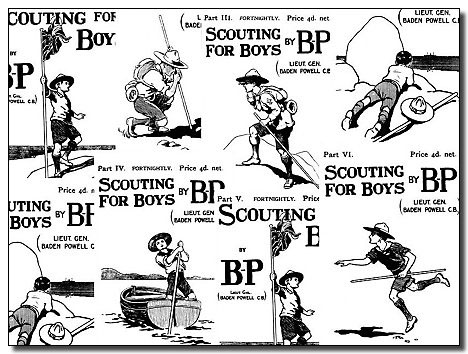
So back to 1910 then. Armed with the guidelines and tips
from "Scouting For Boys", the bible of scouting authored by
BP himself, Mr Shaw briefed that first motley crew of V.I. boys about
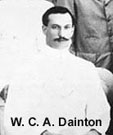 the ideals of scouting. Soon, after a few tests, the boys were invested
with the Tenderfoot Badge, the first step into the brotherhood of Boy
Scouting. They were organised into three patrols, with Mr W.C.A. Dainton
as the Scout Master. He was an expert at signalling and his charges
gained much from his expertise. Apart from his Scouting expertise, Mr
Dainton was also reputed to be an excellent goalkeeper. During the
First World War, Mr Dainton served in the West Riding Regiment of the
British army.
the ideals of scouting. Soon, after a few tests, the boys were invested
with the Tenderfoot Badge, the first step into the brotherhood of Boy
Scouting. They were organised into three patrols, with Mr W.C.A. Dainton
as the Scout Master. He was an expert at signalling and his charges
gained much from his expertise. Apart from his Scouting expertise, Mr
Dainton was also reputed to be an excellent goalkeeper. During the
First World War, Mr Dainton served in the West Riding Regiment of the
British army.
The names of the first Scouts of the V.I. and of Malaya are listed below. They constituted the First Selangor Scout Group as of Friday, 23 September, and were submitted to the Boy Scouts Headquarters in London for registration. It must be noted that according to the minutes of the first Local Committee meeting, there were in fact three patrols that were formed in early 1910, while the list that follows contains four patrols. This is probably because this list includes additional Scouts who had been recruited after the success of the early three patrols. In other words, this list probably contains the names of not just the original Scouts but also those who joined a few months later. Notwithstanding that, this is an important list because it is the earliest known record of the names of the first Scouts of Malaya.
C. Koch (probably G.C.S. Koch) - Leader
N Appathuray - Corporal
H.B. Chinnadurai
N. Seenderajah
Wong Fook Han
A. Carroll
R. Kugathasan
A. Sivasanibo
WOLF PATROL
Ng Bow Huah - Leader
Chiew Sze Chan - Corporal
P. Nadarajah
Yong Shook Lin (see A Gallery of Scouting Greats)
Tay Lian Hee
K. Muttiah
John Hugh
G. Krishnasamy
TIGER PATROL
G. Foenander - Leader
Mohamed Ameen Akbar - Corporal
D.M. Wasagam
P. Tambimuttu
K. Sabapathy
K.S. Arumugam
L.P.Koch
E.H. Cowan
EAGLE PATROL
A.K. Rajendra - Leader
L. Robert - Corporal
Yap Kon Fah
S.V. Siva Kuru
Tay Lian Teck
S. Thiliampalam
Hiram
Edward
EXPERIMENTING AND REORGANISING
In 1910, Mr Shaw sought to register the Troop with the Imperial Headquarters in London, but was instructed to refer the matter to the local association, which was then in Singapore, one founded by a Mr Frank C. Sands. In those early years, there were many changes of Scout Masters, beginning in 1910 when the School's first Scoutmaster, Mr Dainton, left for Java:
Mr Goodman Ambler (1910),Lieutenant George Barber (1911/1912),
Mr C.G. Coleman (1912/1914)
Mr M. Wheatley and
Mr E.S. Redfearn (1921).
Mr Ambler was the first acting Secretary of the Local Committee
of the Selangor Boy Scouts, which convened its first meeting at the Selangor
 Club at 7 p.m. on Wednesday, 28 September, 1910. He was one of the first
V.I. European masters to leave for England for the war after he was
granted nine months’ leave. Back in Europe, he held the rank of Captain,
serving in the 12th Battalion of the Royal Sussex Regiment. For his
courage and loyalty (including being wounded three times and mentioned
in dispatches), he was awarded the Military Cross for conspicuous
Club at 7 p.m. on Wednesday, 28 September, 1910. He was one of the first
V.I. European masters to leave for England for the war after he was
granted nine months’ leave. Back in Europe, he held the rank of Captain,
serving in the 12th Battalion of the Royal Sussex Regiment. For his
courage and loyalty (including being wounded three times and mentioned
in dispatches), he was awarded the Military Cross for conspicuous
 gallantry. He returned to the V.I. in January 1920. When England declared
war against Germany in August 1914, Lieutenant Barber left the School in
November of that year for the European front, where he held the rank of Second
Lieutenant in the 18th Battalion, Royal Fusiliers. In his absence, Mr Coleman,
the then Chief Assistant Master of the V.I. took charge of the Troop, acting
in the office of Scout Master. Meanwhile, Mr Wheatley’s application to join
the armed forces was rejected owing to defective eyesight. Soon the sad news
gallantry. He returned to the V.I. in January 1920. When England declared
war against Germany in August 1914, Lieutenant Barber left the School in
November of that year for the European front, where he held the rank of Second
Lieutenant in the 18th Battalion, Royal Fusiliers. In his absence, Mr Coleman,
the then Chief Assistant Master of the V.I. took charge of the Troop, acting
in the office of Scout Master. Meanwhile, Mr Wheatley’s application to join
the armed forces was rejected owing to defective eyesight. Soon the sad news
 came back that George Barber, while serving his King and country, had been killed
at Lesboeufs in France, on 3 October, 1916. He had been in the First Battle of
the Somme, an offensive launched by the Allies in July 1916 along a 21-mile
front against the Germans. The casualties were horrendous - the British sustained
20,000 dead on the first day alone - and when the offensive ended four months
later the Allies had gained a mere eight miles. The former V.I. Scout Master, 27
at that time, was just one statistic in the 420,000 British casualties. George
Barber was survived by his parents, Henry and Harriett Barber of Macclesfield,
Cheshire. In the early 1920’s, after serving ably as Scout Master, Mr Redfearn
was appointed to the post of District Commissioner. It must be remembered that,
unlike the present, the district at that time was the whole of the state of
Selangor! But apart from being a keen Scout leader, Mr Redfearn was also known
as an excellent geography master.
came back that George Barber, while serving his King and country, had been killed
at Lesboeufs in France, on 3 October, 1916. He had been in the First Battle of
the Somme, an offensive launched by the Allies in July 1916 along a 21-mile
front against the Germans. The casualties were horrendous - the British sustained
20,000 dead on the first day alone - and when the offensive ended four months
later the Allies had gained a mere eight miles. The former V.I. Scout Master, 27
at that time, was just one statistic in the 420,000 British casualties. George
Barber was survived by his parents, Henry and Harriett Barber of Macclesfield,
Cheshire. In the early 1920’s, after serving ably as Scout Master, Mr Redfearn
was appointed to the post of District Commissioner. It must be remembered that,
unlike the present, the district at that time was the whole of the state of
Selangor! But apart from being a keen Scout leader, Mr Redfearn was also known
as an excellent geography master.
The appeal of Scouting began to catch on in the V.I. like
wild fire. The burgeoning V.I. Troop, which had started with three patrols in
1910 and increased to four patrols in September 1910 and then to 12 patrols of
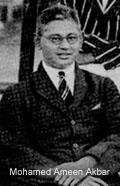 eight members each in 1912, desperately needed leaders. And so the post
of Assistant Scout Master was created, filled by the able teachers of
the School. In 1910, two Assistant Scout Masters were appointed, namely,
Mr Ng Seo Buck and Mr Wong Fook Yew. When they left the Troop in 1912 to
become Officers in the Cadet Corps, five Assistant Scout Masters were
appointed to replace them, namely, Messrs Mohamed Ameen Akbar, Wee Kok
eight members each in 1912, desperately needed leaders. And so the post
of Assistant Scout Master was created, filled by the able teachers of
the School. In 1910, two Assistant Scout Masters were appointed, namely,
Mr Ng Seo Buck and Mr Wong Fook Yew. When they left the Troop in 1912 to
become Officers in the Cadet Corps, five Assistant Scout Masters were
appointed to replace them, namely, Messrs Mohamed Ameen Akbar, Wee Kok
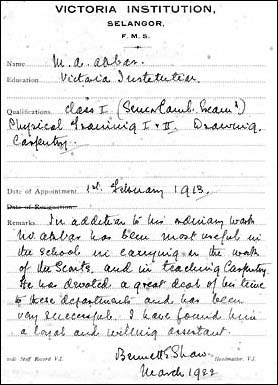 Thai, N. Appadurai/ Appathuray, Tay Lian Hee, and K. Sabapathy.
Interestingly, the names of five V.I. ASM’s - Fook Han, Akbar,
Appadurai, Lian Hee and Sabapathy - are also found on the first 1910
list of the V.I. Scouts submitted by Mr Ambler and Mr Shaw to the London
Headquarters in order to register the First Selangor Boy Scout Troop.
Kok Thai, though not in the pioneer batch, was nonetheless one of the
early recruits of the V.I. Scouts in 1910. Such a trend is not
surprising as Mr Shaw started the V.I. tradition (continued at least
until the 1960’s) of actively recruiting Old Boys to join the V.I. Staff.
This tradition was arguably the cornerstone in ensuring the V.I. was
staffed by high quality teachers who were committed to the school.
Thai, N. Appadurai/ Appathuray, Tay Lian Hee, and K. Sabapathy.
Interestingly, the names of five V.I. ASM’s - Fook Han, Akbar,
Appadurai, Lian Hee and Sabapathy - are also found on the first 1910
list of the V.I. Scouts submitted by Mr Ambler and Mr Shaw to the London
Headquarters in order to register the First Selangor Boy Scout Troop.
Kok Thai, though not in the pioneer batch, was nonetheless one of the
early recruits of the V.I. Scouts in 1910. Such a trend is not
surprising as Mr Shaw started the V.I. tradition (continued at least
until the 1960’s) of actively recruiting Old Boys to join the V.I. Staff.
This tradition was arguably the cornerstone in ensuring the V.I. was
staffed by high quality teachers who were committed to the school.
Some of these early ASM’s are now regarded as legends of
the Scouting movement for the region. Mr Sabapathy later left the V.I. to
join another eminent institution of the region, where he sowed the Scouting
seed - in 1922, he helped found the Scout movement in the Raffles
Institution in Singapore. This group later became the Second Singapore
Troop. Meanwhile back in Malaya, Mr Akbar was making his mark as the
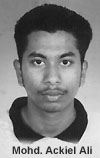 Scouting stalwart of Selangor. Even in those early years, he was already
well recognised. In 1925, Mr Akbar was appointed as the Acting District
Scoutmaster for Selangor (vice Mr Redfearn who was on leave to England) and,
subsequently, was officiated into that capacity. He held that position
simultaneously with his role as Assistant District Commissioner for Selangor.
In these roles, he promoted the Scouting movement among schools in Selangor,
feats which will be highlighted in the following paragraphs. For all of his
gallant efforts, Mr Akbar was awarded the Bar to the Medal of Merit by Lord
Baden Powell himself, when the Chief Scout visited Malaya. In 1993, a
spiritual link with Mr Akbar was forged in the V.I. when his grandson, Mohd
Ackiel Ali (another M.A.A.!) joined Falcon patrol of the Second KL Scout Group
as a Form 1 member! Ackiel later became the PL of Eagle patrol in 1995.
Scouting stalwart of Selangor. Even in those early years, he was already
well recognised. In 1925, Mr Akbar was appointed as the Acting District
Scoutmaster for Selangor (vice Mr Redfearn who was on leave to England) and,
subsequently, was officiated into that capacity. He held that position
simultaneously with his role as Assistant District Commissioner for Selangor.
In these roles, he promoted the Scouting movement among schools in Selangor,
feats which will be highlighted in the following paragraphs. For all of his
gallant efforts, Mr Akbar was awarded the Bar to the Medal of Merit by Lord
Baden Powell himself, when the Chief Scout visited Malaya. In 1993, a
spiritual link with Mr Akbar was forged in the V.I. when his grandson, Mohd
Ackiel Ali (another M.A.A.!) joined Falcon patrol of the Second KL Scout Group
as a Form 1 member! Ackiel later became the PL of Eagle patrol in 1995.
Organising the V.I. troop was no mean feat as not only was there no precedent for the First Selangor Troop to follow, but also because of the rapid surge of interest in Scouting among the boys. The original three patrols grew to six patrols in 1911. The following year, the total strength of the Troop was about a hundred. By the time Mr Barber left in 1914, the Troop was about two hundred and fifty strong, an extraordinary number considering that there were only about five hundred pupils in the school at that time. As well, almost all Form Masters in the school were already Scouters. Initially, the School managed such rapid growth by increasing the number of patrols and Assistant Scout Masters. But by March 1923, there were 11 patrols; their patrol leaders were Lee Ah Swee, Chan Khee Hong, Mohamed (I) , Mohamed (II), Mohamed Sulong, Abdul Rahman, Mohamed Yacob, Lim Thin Chan, Keher Singh, Kwok Ah Keng and Vijeratnam. To continue to increase the number of patrols was clearly not feasible and so further restructuring was carried out in the later years.
ACTIVITIES - TROOP EVENTS, COMMUNITY SERVICE, SCOUT EFFICIENCY
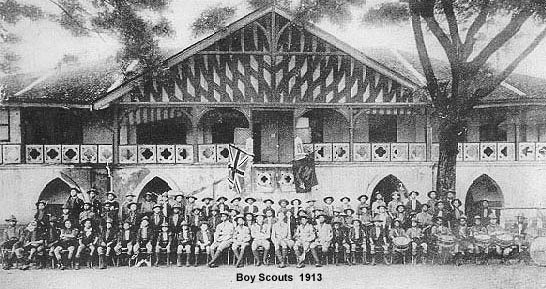
So what was scouting in those infant years like? As the movement was still highly disorganised at that time, there was no standard uniform. But resourcefulness supplied the necessities. For instance, bamboo broom stick handles were used as Scout staffs. Troop meetings were held on Saturdays. There was a variety of activities; for instance, in 1911, Scouting games took place at the Lake Gardens. Indeed, the ‘out-of-door' Scout was common in those years and the patrols were often seen out-of-doors Scouting around KL. Camping was an important feature of the Scouting calendar. The first Scout camp for the V.I. boys (and possibly the whole of Malaya) was held during the August holidays in 1913 at Port Dickson and about 76 Scouts and officers attended, under the leadership of Mr Barber. In August 1916, a short camp for forty Scouts was held at Kelewai in Penang under Chief Assistant Scout Master (CASM) Akbar. He also presided over a camp in Malacca in August 1919, as well as over a short camp at Batang Kali in the Ulu Selangor district in August 1922.
Such accomplishments should not be judged by present standards. It must be remembered that in that far-off era, there was no organised public transport, what more a school bus, to ferry the Scouts to their destinations. Even if there had been such infrastructure, most pupils would have been too poor to afford such luxury. Much of Kuala Lumpur and its environs was still carpeted with thick jungle - indeed, one should not forget that those were the days when V.I. masters carried guns to shoot stray crocodiles that not infrequently lurked on the school grounds. Even in the 1930’s, as recalled by Tan Sri Dato’ Dr Abdul Majid Ismail, the Scouts merely hitched rides in factory lorries if they wanted to travel long distances, so what more the 1910’s. So it is in this context that we in the present should regard their camping feats, and other achievements as well, like the time, in December 1921, when 25 Scouts marched from Kuala Lumpur to Port Swettenham (now Port Klang), covering a distance of 29 miles in one day. Given the wild terrain on the route in those days, it must have been quite an epic march!
There were many other activities which helped to foster the ideals of Scouting amongst the V.I. Scouts. The Scouts served the community at large by participating in community events. One large civic event for Malaya in which the Scouts played an important role was the official visit of the Prince of Wales. The V.I. Scouts formed a guard of honour to welcome to Kuala Lumpur the heir to the British throne when he arrived on 28 March 1922. (This same Prince of Wales would later, in January 1936, become King Edward VIII but would infamously abdicate to marry a commoner, Mrs Wallis Simpson.)
The Empire Day celebrations each May were also important
public functions for the Scouts. On Empire Day in 1922, for instance, the
Troop was inspected by the Chairman of the V.I. Board of Trustees, Mr E.W.N.
Wyatt. The following year, the Troop numbering 50 Scouts lined up for
the march past led by Scout Master Mr Redfearn. Taking the salute was the
Sultan of Selangor, Sultan Alauddin Sulaiman Shah, accompanied by the
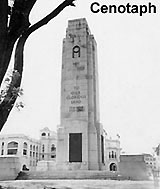 Raja Muda, Dato Setia Diraja, the Secretary to the Resident and the V.I.
Headmaster, Mr Richard Sidney. Another important annual event at which
the Scouts paraded was Armistice Day, also known as Poppy Day. Held on
the 11th day of the 11th month every year, it commemorates the end of
the First World War. The official function would take place in front of
the Cenotaph which used to be located at what is today Jalan Tugu,
beside the Kuala Lumpur Railway Station .
Raja Muda, Dato Setia Diraja, the Secretary to the Resident and the V.I.
Headmaster, Mr Richard Sidney. Another important annual event at which
the Scouts paraded was Armistice Day, also known as Poppy Day. Held on
the 11th day of the 11th month every year, it commemorates the end of
the First World War. The official function would take place in front of
the Cenotaph which used to be located at what is today Jalan Tugu,
beside the Kuala Lumpur Railway Station .
Besides community service, there was also socialising. During their trip to Penang in 1916, the V.I. Scouts struck up a close friendship with the Scouts of the Penang Free School and with Mr H.R. Cheeseman who was the Scout Master for P.F.S. - perhaps one of the earliest account of ‘pen-palling’ in Malaya! Indeed, the friendship continued for many years, and it is recorded that after the Prince of Wales parade on 28 March 1922, the V.I. Scouts fraternised with the Penang Scouts who were in the Federal Capital on a casual visit. The V.I. Scouts extended their friendship not just to other Scouts; in August 1922, during the camp at Batang Kali, the Scouts climbed Gunung Ulu Kali and visited the Sakais in the interior of the jungle.
It would be remiss for the administration to claim a job well done
 for merely organising the V.I. Troop. Indeed, even well organised Troops can
eventually collapse if the business of Scouting is not properly carried
out. In order to increase the efficiency of the Scouts, many
strategies were devised. One specific strategy was the forming of
‘specialist’ sections. In early 1920, CASM Akbar and the Superintendent
of the Selangor Fire Brigade, Mr W. Towle, formed the ‘Fire Section’ of
the First Selangor Troop with a nucleus of 12 Scouts. This was, in fact,
the first section to be formed east of the Suez Canal! There was also an
Ambulance Section which was trained by Mr F.C. Barraclough, a V.I.
teacher. Each year on Empire Day, there would be special displays put
up by these sections to demonstrate their specialist skills. For
instance, the ‘Fire Scouts’ would put up some sort of hut on the School
field, set the hut on fire, and then extinguish the blaze.
for merely organising the V.I. Troop. Indeed, even well organised Troops can
eventually collapse if the business of Scouting is not properly carried
out. In order to increase the efficiency of the Scouts, many
strategies were devised. One specific strategy was the forming of
‘specialist’ sections. In early 1920, CASM Akbar and the Superintendent
of the Selangor Fire Brigade, Mr W. Towle, formed the ‘Fire Section’ of
the First Selangor Troop with a nucleus of 12 Scouts. This was, in fact,
the first section to be formed east of the Suez Canal! There was also an
Ambulance Section which was trained by Mr F.C. Barraclough, a V.I.
teacher. Each year on Empire Day, there would be special displays put
up by these sections to demonstrate their specialist skills. For
instance, the ‘Fire Scouts’ would put up some sort of hut on the School
field, set the hut on fire, and then extinguish the blaze.
A more general strategy to promote Scouting efficiency was to encourage the boys to acquire badges. Even in the infant days of the movement in Selangor, there were many tests to be taken. Among those in 1911 were Automobiles, Carpentry, Photography, Swimming, Life-saving, Ambulance, Pathfinding, Housemanship, Fire Brigade, Cycling, Pioneering and Blacksmith. The First Selangor Troop capitalised on the skills of its Scout Masters and external instructors for many of these tests. For instance, the Ambulance section was examined by a Dr Graham and the successful candidates earned the popular Red Cross badges. As well, involvement in the above-mentioned ‘specialist’ sections was useful, as evinced when a mere three years after the formation of the ‘Fire Scouts’, there were already 16 Scouts who qualified for the Fireman’s badge, three of whom proceeded to earn the King Scout badge. In addition to specialist instruction and badge-taking, Mr Redfearn, who took over the Troop in 1921, is credited with encouraging friendly patrol rivalry with a resulting increase in Troop efficiency.
V.I. SCOUTS BLAZE THE TRAIL

In addition to having the first Scout group in Malaya, the V.I. was a pioneer in many contexts. Chief Patrol Leader Choong Wan Chan became the first Boy Scout of the group to qualify as a King Scout in 1922. In doing so, he also became the first King Scout in Selangor. At the end of that year, he was the first student to be appointed to the role of Assistant Scout Master. Besides being an efficient Scout, Wan Chan was also a school prefect, and a member of the first Editorial Board of The Victorian. So versatile was he that he also trained the V.I. Cadet Corps shooting team. Under him, the cadets achieved a high level of marksmanship, carrying off the Leslie Shield in its inaugural year of 1925, which was open for competition to all Cadet Corps in the Federated Malay States. Close on Wan Chan's heels were two more King Scouts, namely, PL Wan Chong Chow and Scout Lee Ah Swee.
The V.I. Scouts were also instrumental in spreading the
Scouting movement to other schools by helping them to start their own Scout
Troops. For example, in 1925, Reverend Abel Eklund, Principal of the
Anglo-Chinese School Klang invited Mr Akbar to raise a Troop in Klang.
Mr Akbar addressed no fewer than 100 boys when he attended that inaugural
meeting. The following year, Mr Akbar also started a Troop at the Maxwell
Road School, at the invitation of the Headmaster Mr C. Beamish. The
first Scout Master (Mr K. Peethamparam) and two Assistant Scoutmasters
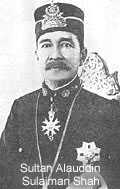 (Messrs Ujagar Singh and J.M. Idris) of that budding Troop were former
members of V.I.'s First Selangor Troop! By that time, the first Wolf Cub
Pack for Selangor had already been formed in the Victoria Institution
in 1922. (Prior to 1930, the V.I. had both a primary as well as a
secondary school.) This Pack, affiliated with the First Selangor Troop,
was placed under the charge of Mr Chan Hung Chin.
(Messrs Ujagar Singh and J.M. Idris) of that budding Troop were former
members of V.I.'s First Selangor Troop! By that time, the first Wolf Cub
Pack for Selangor had already been formed in the Victoria Institution
in 1922. (Prior to 1930, the V.I. had both a primary as well as a
secondary school.) This Pack, affiliated with the First Selangor Troop,
was placed under the charge of Mr Chan Hung Chin.
Indeed, the First Selangor Troop was quick to earn its laurels. During the 1923 Empire Day, the Sultan of Selangor, Sultan Alauddin Sulaiman Shah, was deeply impressed by the parade and the displays by the Scouts. He was surprised that, prior to that time, no one had informed him that there were Boy Scouts in his State! So impressed was he that he promised to pay another visit in the near future. At the same time the Raja Muda was also very pleased with what he saw and offered to present the Royal Colours to the Troop. Surviving records do not tell whether the Colours were, in fact, actually presented to the Troop. However, it is recorded that this offer of Royal Colours was, without doubt, the first to be made to a Troop in British Malaya!
 The V.I. Web Page
The V.I. Web PageLast update on 23 November 2003.
Pagekeeper: Chung Chee Min